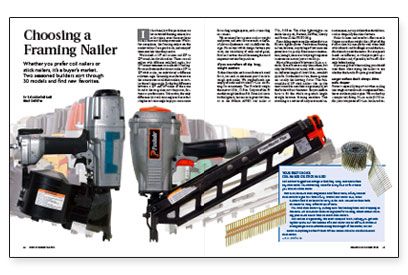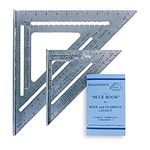Choosing a Framing Nailer
Whether you prefer coil nailers or stick nailers, it's a buyer's market. Two seasoned builders sort through 30 models and find new favorites.

Synopsis: A survey of 30 air-powered framing nail guns that takes into account their physical dimensions, power, triggering mechanism, type of fastener (stick or coil), and price. The survey also includes a subjective assessment of the job-site performance of each tool, and recommendations. Includes a sidebar discussing the merits of stick vs. coil nailers.
It has been just five years since we last reviewed framing nailers; but in that time, even the most basic models show notable improvements. With a few exceptions, the framing nailers on the market today all are good tools, and many of them cost less than they used to.
We looked at 15° coil nailers and 20° to 22° round-head stick nailers. There are coil nailers with different nail-feed angles, but 15° is most common in residential framing. For manufacturers that do not make a 20° to 22° stick nailer, we substituted a different collation angle. Generally, manufacturers use the same motor on all their nailers, no matter the collation angle. So the big difference between a 22° and 34° nailer of the same brand is the magazine, not the power, features, or performance. Otherwise, the only difference that collation angle makes is that a higher collation angle buys you some room for nailing in tight spaces, such as toenailing in a corner.
We examined basic points such as weight and power, and extra features such as depth-of-drive adjustments and air-deflector design. No matter which design features you want, the availability of nails and of good, fast local service should be among the most important criteria for purchase.
If you use nailers all day long, weight matters
Rather than take each manufacturer’s word for it, we used an electronic postal scale to weigh each nailer. We weighed each one empty of nails and attached a 1 ⁄4-in. air fitting for consistency. The Haubold weighs the most at 10 lb. 11.8 oz. Only six of the 30 models weigh less than 8 lb. Several claim to be the lightest, but our scale gives that honor to the Makita AN901 coil nailer at 7 lb. 0.08 oz. The other lightweights are sticks: the Apach, Bostitch, DeWalt, Grizzly, and Porter-Cable FR350 Mag.
Remodeling requires smaller nailers that can fit into tighter places. Production-framing nailers, however, may be large if that increases power or nail capacity. Even in new construction, though, there are always tight squeezes in corners or narrow joist or stud bays.
Most of the nailers fit between 16-in.-o.-c. stock. Some fit more easily than others, but only the Makita coil nailer, with a nose-to-air-deflector length of about 16 in., wouldn’t quite fit. On the stick nailers, the magazines are usually the limiting factor. The full round-head 20° stick nailers take up the most room because their magazines project the farthest from the motor. But you seldom have to fit the whole magazine’s length straight between framing members. This crowding is a matter of only occasional inconvenience, not a problem that should outrank or disqualify the other features.
Nailer balance and comfort affect muscle fatigue more than weight does. Most of the stick nailers balance pretty well when held with a thumb and forefinger around the handle where it meets the motor. But everyone’s hands are different, so it helps to pick up a lot of nailers and, if possible, to fire off a few nails before buying.
For more photos and details, click the View PDF button below:
Fine Homebuilding Recommended Products
Fine Homebuilding receives a commission for items purchased through links on this site, including Amazon Associates and other affiliate advertising programs.

Speed Square

Get Your House Right: Architectural Elements to Use & Avoid

Sledge Hammer


























